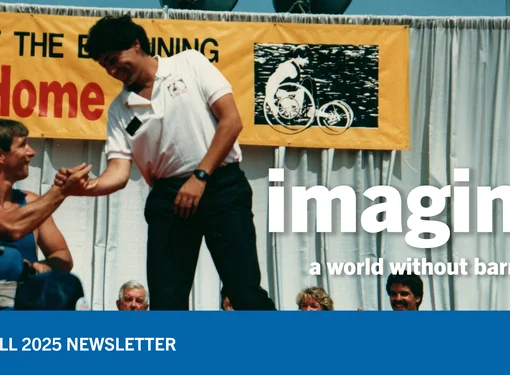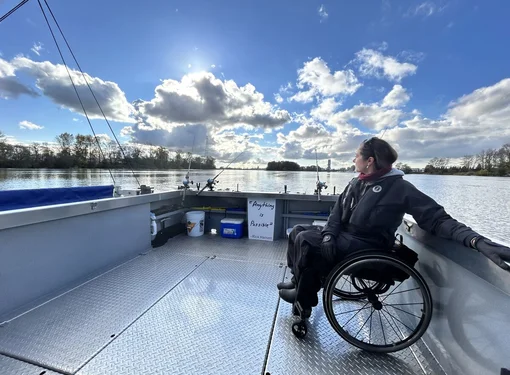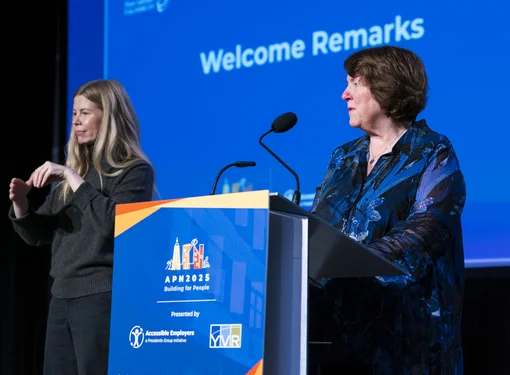Accessible cities: How New Westminster is leading the way (Part 2)
Above image: Pedestrians crossing a street in uptown New Westminster, British Columbia. (Credit: Wikimedia Commons)
(Click here to read Part 1 of our interview)
Recently, we had a chance to ask Mayor Jonathan X. Coté of New Westminster, British Columbia some questions about his city's accessibility initiatives.
In our second part of the interview, we find out about the city's engagement with seniors and people with disabilities to ensure collaboration in creating a more accessible community.
(Editor's note: Some answers have been edited for length, grammar, and clarity.)
4. One of the stats we saw involved having over 80% of bus stops accessible in your city. How did you make this possible and what kind of effort is needed to achieve that?
In May 2014, 83.3% of bus stops were accessible in New Westminster, which ranked the city second among municipalities with at least 10 bus stops in Metro Vancouver.
The City has an Accessible Transit Stop Program, which is working towards all bus stops, where feasible, being accessible. Of the 50 remaining non-accessible bus stops, 39 are slated to be-come accessible by 2016.
The remaining 11 bus stops cannot be made accessible due to steep grades but other accessibility enhancements are being contemplated. As such, having a dedicated program and working closely with TransLink has been essential to ensuring success.
As such, having a dedicated program and working closely with TransLink (Vancouver's regional public transit authority) has been essential to ensuring success.
 Above image: New Westminster's accessibility plans must consider its historic buildings and sometimes steep terrain – which is no easy task. (Credit: Wikimedia Commons)
Above image: New Westminster's accessibility plans must consider its historic buildings and sometimes steep terrain – which is no easy task. (Credit: Wikimedia Commons)
5. New Westminster has many hills. Making a city like that accessible is a huge task. What keeps you persevering despite such challenges?
The City has an excellent public transit system and, as noted, a strong network of accessible bus stops, which enables residents to access all parts of the city, despite the steep topography. Additionally, residents can meet many of their daily needs within their neighbourhood, which reduces the need to travel between neighbourhoods.
The City, as part of the Wheelability Assessment Project, conducted a comprehensive accessibility audit of the Uptown and Downtown neighbourhoods. As part of this audit, maps were created which provided information related to gradients (i.e., 1-4%, 5-8%, 9-12%).
In this way, seniors and people with disability, including users of mobility devices, could make informed deci-sions as to possible routes when travelling between these two neighbourhoods. In some cases, seniors and people with disabilities step their way up (i.e., one block up and one block across) in order to travel uphill.
Increasingly, electric wheelchairs and scooters have a higher watt rating related to their motors, which enables them to handle demanding terrain and a heavier load. As such, these devices are able to climb and negotiate many of the hills in New Westminster.
 Above image: General view of downtown New Westminster, a major business area and gathering spot. (Credit: jmv from Flickr.)
Above image: General view of downtown New Westminster, a major business area and gathering spot. (Credit: jmv from Flickr.)
6. Of course, you cannot have an accessible city without private businesses and people cooperating. How would you encourage them to help make their communities accessible?
The City has various mechanisms for reviewing public infrastructure and private developments to ensure that they maximize accessibility. The City has an Access Ability Advisory Committee, an ActBiped Advisory Committee (for Transit, Bicycles and Pedestrians) and a Seniors Advisory Committee, which advise City Council on issues related to accessibility and an aging population.
These bodies review developments and undertake other initiatives to enhance accessibility. City staff, as part of the development approvals process, also review private developments with a view to enhancing accessibility.
The Access Ability Advisory Committee has produced a series of videos, which are available on YouTube. These videos are designed to raise public awareness about accessibility, including tips as to how individual members can made a difference.
For example, leaving adequate space adjacent disabled parking spaces for occupants to comfortably and safely exist and trimming foliage bordering sidewalks. The Seniors Advisory Committee undertook an Age Friendly Business Initiative, in association with the Chamber of Commerce, to educate businesses as to the bene-fits are making their premises more accessible and age friendly.
City Council has participated in education and training sessions. For example, Councilors participated in the Wheelability Assessment Project and took Dementia-Friends training. These opportunities assist Councilors in their decision-making related to development projects.
7. What kinds of access do you envision in the future, both for your city and the region as a whole?
The City is committed to becoming one of the most accessible cities in Metro Vancouver and the Province. To this end, the City will continue to work towards an Age and Ability Friendly City, whereby it adapts its structures and services to be accessible to and inclusive of people with varying needs and capacities.
The City wants to ensure that residents can live as independently as possible, can age in place, can actively participate in the community and can make a meaningful contribution. The City has made tremendous strides towards this goal and will continue to work with seniors and people with disabilities to make this goal a reality.
Missed Part 1 of our interview? Click here!
The Rick Hansen Foundation thanks Mayor Coté for taking the time to speak with us and share his city's goals, accomplishments, and vision.






